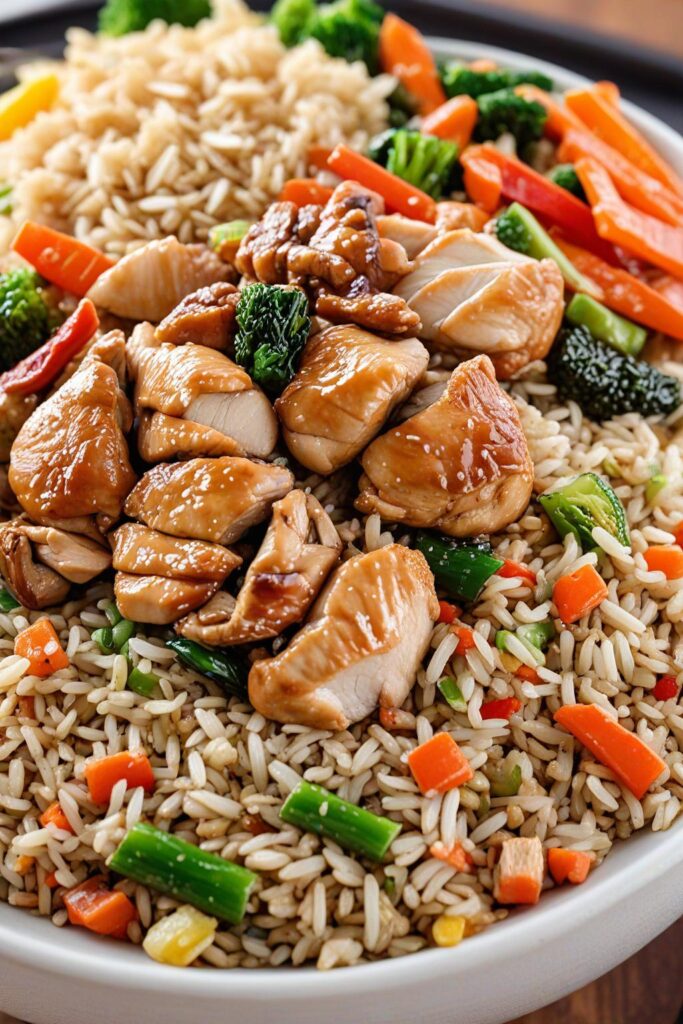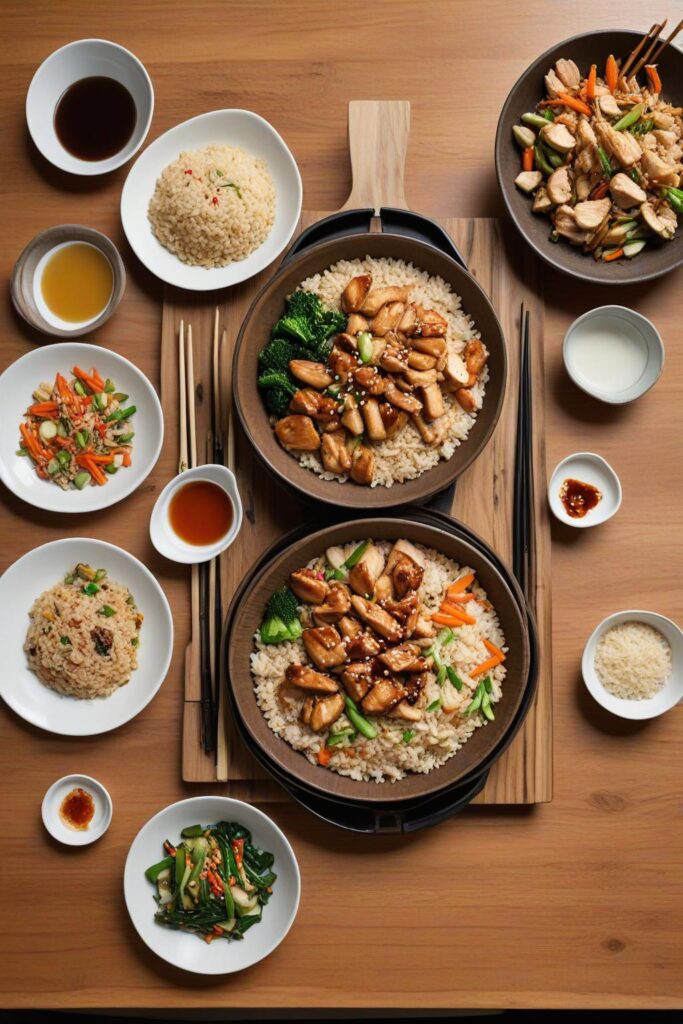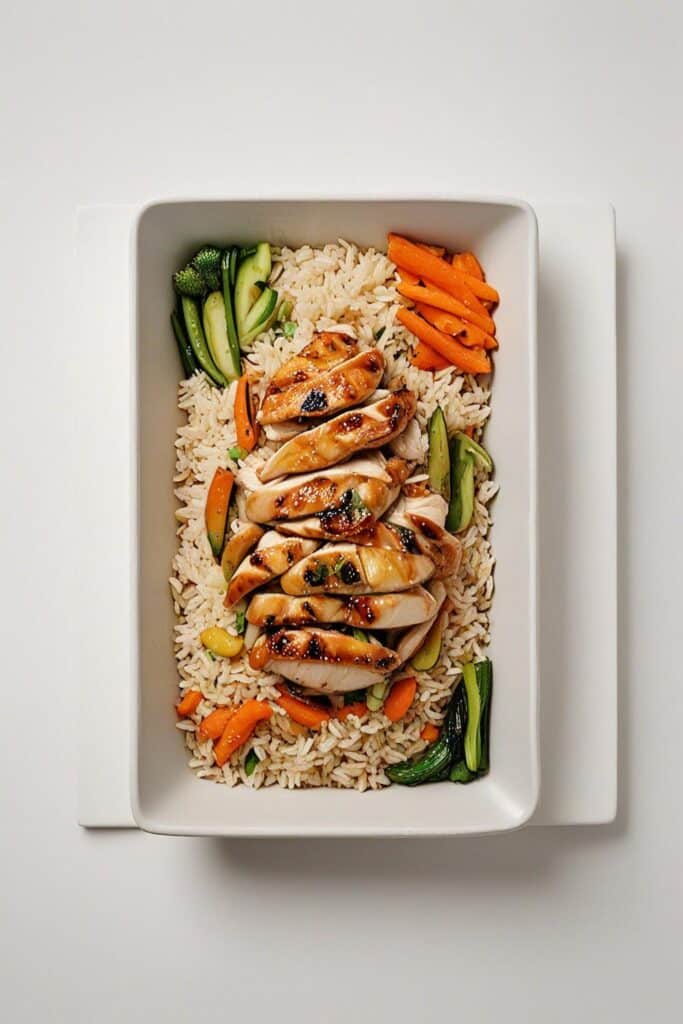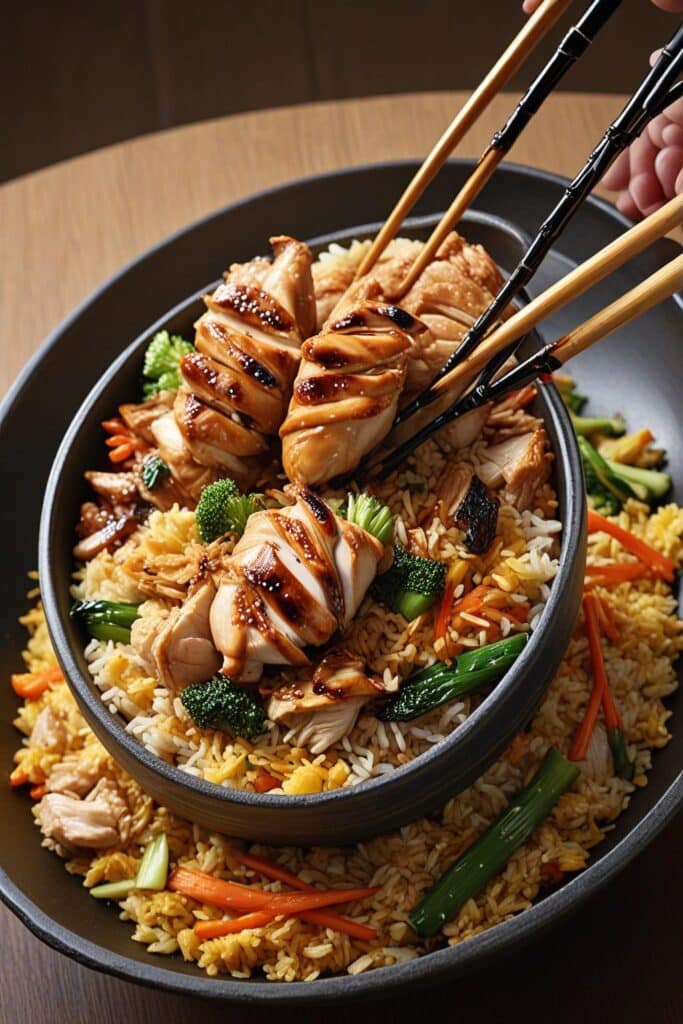The first time I watched a hibachi chef work his magic, I was mesmerized by the rhythmic clatter of spatulas against the steel surface. The way he transformed simple ingredients into a symphony of sizzling sounds and aromatic clouds left me wondering—could this theatrical cooking style translate to a home kitchen? After years of perfecting this technique, I can confidently say: absolutely.
Hibachi chicken and vegetables with fried rice isn’t just a meal; it’s an experience that brings restaurant-quality entertainment straight to your dinner table. This dish represents the westernized version of Japanese teppanyaki, where high-heat cooking creates those coveted caramelized edges and smoky flavors that make each bite unforgettable.
What Makes Hibachi Cooking Special
The magic of hibachi lies in its simplicity and precision. Unlike complex French techniques or intricate Asian preparations, hibachi cooking relies on three fundamental elements: high heat, quality ingredients, and proper timing. The cooking surface—traditionally a flat iron griddle—reaches temperatures exceeding 500°F, creating the Maillard reaction that gives proteins their golden-brown crust and vegetables their perfect char.
What sets professional hibachi apart from home cooking isn’t just the showmanship. It’s the understanding of how different ingredients respond to intense heat and the choreographed sequence that ensures everything finishes simultaneously. The chicken develops a crispy exterior while remaining juicy inside, vegetables retain their crunch despite the high temperature, and the fried rice achieves that elusive “wok hei”—the breath of the wok that gives it its distinctive smoky flavor.
Ingredients & Substitutions

For the Hibachi Chicken:
- 2 lbs boneless, skinless chicken thighs (preferred over breasts for superior flavor retention)
- 3 tablespoons vegetable oil with high smoke point
- 2 tablespoons soy sauce (low-sodium preferred)
- 1 tablespoon mirin or rice wine
- 1 teaspoon garlic powder
- 1 teaspoon onion powder
- 1/2 teaspoon white pepper
- 1/4 teaspoon ground ginger
For the Vegetables:
- 1 large zucchini, sliced into half-moons
- 1 large yellow onion, cut into wedges
- 8 oz mushrooms (cremini or shiitake work best)
- 2 cups broccoli florets
- 1 red bell pepper, julienned
- 2 tablespoons butter
- Salt and pepper to taste
For the Fried Rice:
- 4 cups day-old cooked white rice (jasmine or medium-grain preferred)
- 3 large eggs, beaten
- 3 green onions, finely chopped
- 2 cloves garlic, minced
- 2 tablespoons soy sauce
- 1 tablespoon oyster sauce
- 2 tablespoons vegetable oil
- 1 teaspoon sesame oil
- Salt and white pepper to taste
Professional Substitution Tips:
Chicken thighs can be replaced with chicken breasts, but reduce cooking time by 25% to prevent drying. For a budget-friendly option, chicken tenderloins work exceptionally well and cook even faster.

If you can’t find mirin, substitute with 1 tablespoon rice vinegar plus 1/2 teaspoon sugar. This maintains the subtle sweetness that balances the soy sauce’s saltiness.
Day-old rice is crucial for proper fried rice texture—fresh rice becomes mushy when stir-fried. If you only have fresh rice, spread it on a baking sheet and refrigerate for at least 2 hours before using. This removes excess moisture and prevents clumping.
Vegetable oil can be substituted with avocado oil or refined coconut oil, both of which have high smoke points necessary for hibachi cooking. Avoid olive oil, which burns at high temperatures and creates bitter flavors.
Step-by-Step Instructions
Preparing the Chicken
Start by cutting your chicken thighs into bite-sized pieces, roughly 1-inch cubes. This size ensures even cooking while maximizing surface area for caramelization. Pat the chicken completely dry with paper towels—excess moisture is the enemy of proper browning.
In a medium bowl, combine soy sauce, mirin, garlic powder, onion powder, white pepper, and ginger. Add the chicken pieces and toss to coat evenly. Let this marinate for at least 15 minutes, though 30 minutes produces noticeably better flavor penetration.
The key mistake most home cooks make is overcrowding the pan. When chicken pieces touch each other, they steam rather than sear. This creates gray, rubbery texture instead of the golden-brown crust we’re after.
Mastering the Vegetable Preparation
Cut all vegetables to similar sizes for even cooking. Zucchini should be sliced into half-moons about 1/4-inch thick. Onions work best when cut into wedges that hold together during cooking. Mushrooms should be quartered if large, halved if medium-sized.
Broccoli florets require a quick blanching step that many recipes skip. Bring a pot of salted water to boil, add broccoli for exactly 90 seconds, then immediately transfer to ice water. This pre-cooking ensures the broccoli finishes at the same time as other vegetables without becoming mushy.
The Rice Foundation
The secret to restaurant-quality fried rice lies in preparation and temperature control. Remove your day-old rice from the refrigerator 30 minutes before cooking to take the chill off. Cold rice straight from the fridge can lower your pan temperature too dramatically.
Break up any rice clumps with your hands before cooking. Large clumps won’t separate properly once they hit the hot oil, leading to uneven texture and burnt spots.
Cooking Sequence: The Professional Approach
Heat is everything in hibachi cooking. Use the highest heat setting your stovetop allows, and don’t begin cooking until your pan is smoking hot. A large cast-iron skillet or heavy-bottomed stainless steel pan works best for home cooking.

Start with the chicken. Add oil to your screaming-hot pan and immediately add chicken pieces in a single layer. Don’t move them for the first 2-3 minutes—this creates the foundational crust. The chicken will release naturally from the pan when it’s ready to flip.
Once the chicken develops a golden crust on one side, flip each piece individually. This takes patience, but the results justify the effort. Cook the second side for another 2-3 minutes until the internal temperature reaches 165°F.
Remove chicken to a plate and tent with foil. The residual heat will finish cooking while you prepare the vegetables, and this resting period allows juices to redistribute throughout the meat.
Vegetable Cooking Technique
Without cleaning the pan (those browned bits add flavor), add butter and let it foam. Add onions first since they take longest to cook. Let them develop some color—about 3-4 minutes—before adding mushrooms.
Mushrooms release considerable moisture when heated. Don’t stir them immediately; let them sear for 2-3 minutes to develop color before moving. This prevents them from becoming soggy and flavorless.
Add bell peppers and zucchini next, followed by the blanched broccoli. The entire vegetable cooking process should take no more than 8-10 minutes. Vegetables should retain some crunch—overcooked vegetables are the hallmark of amateur hibachi.
Fried Rice Execution
Push vegetables to one side of your pan (or remove to a plate if your pan isn’t large enough). Add a bit more oil to the empty space and pour in beaten eggs. Let them set for 30 seconds before scrambling gently.
Add rice to the pan, breaking up any remaining clumps with your spatula. The key technique here is the “toss and fold” method—lift sections of rice and fold them over rather than stirring continuously. This prevents the rice from becoming mushy while ensuring even heating.
Drizzle soy sauce and oyster sauce around the edges of the pan rather than directly on the rice. This prevents cold spots and ensures even distribution as the sauces hit the hot pan surface and sizzle.
Cooking Techniques & Science
The Maillard reaction is the scientific principle that makes hibachi cooking so appealing. This chemical reaction between amino acids and sugars occurs optimally between 280-330°F, creating hundreds of new flavor compounds that give food its distinctive taste and aroma.

High-heat cooking also causes rapid moisture evaporation, concentrating flavors while creating textural contrasts. The exterior of properly cooked hibachi chicken should have a slightly crispy texture, while the interior remains juicy. This is achieved through what culinary scientists call “thermal gradient cooking”—the outside cooks faster than the inside, creating distinct textural layers.
The smoking point of your cooking oil plays a crucial role in flavor development. When oil exceeds its smoke point, it breaks down into bitter compounds that can overpower delicate flavors. This is why professional hibachi chefs use oils with smoke points above 400°F.
Wok hei, the “breath of the wok,” is a flavor that can only be achieved through high-heat cooking. It’s the result of Leidenfrost effect—when rice hits the super-hot surface, moisture instantly vaporizes, creating a protective steam layer that prevents sticking while allowing the rice to toast slightly.
Essential Equipment Considerations
While a traditional hibachi grill creates the most authentic results, a heavy cast-iron skillet or carbon steel pan produces excellent results at home. These materials retain and distribute heat evenly, preventing hot spots that can burn food unevenly.
A thin, flexible spatula becomes essential for proper technique. Thick spatulas can’t get under food properly, increasing the likelihood of tearing delicate proteins or vegetables. Many professional hibachi chefs use two spatulas simultaneously—one for lifting, one for supporting.
Temperature control separates professional results from amateur attempts. If your pan isn’t hot enough, food will steam rather than sear. Too hot, and exteriors burn before interiors cook through. The ideal temperature creates an immediate sizzle when food hits the surface without violent spattering.
Serving & Pairing Suggestions
Presentation plays a significant role in the hibachi experience. Serve immediately on warmed plates to maintain temperature and texture. The contrast between the golden-brown chicken, vibrant vegetables, and fluffy rice creates visual appeal that enhances the dining experience.
Consider serving family-style on a large platter, allowing diners to serve themselves. This communal approach mirrors the traditional hibachi restaurant experience and keeps food warmer longer.
Complementary Flavors and Accompaniments
Yum yum sauce, despite not being authentically Japanese, has become synonymous with American hibachi dining. A simple version combines mayonnaise, tomato paste, rice vinegar, and a touch of sugar. The creamy, slightly sweet sauce provides a cooling contrast to the intensely flavored proteins and vegetables.

Ginger dressing offers a lighter alternative that won’t compete with the dish’s smoky flavors. Traditional Japanese ginger dressing contains fresh ginger, rice vinegar, soy sauce, and a neutral oil—preferably grapeseed or vegetable.
A simple miso soup makes an excellent starter, its umami-rich broth preparing the palate for the bold flavors to come. The fermented soybean paste contains glutamates that enhance the perception of savory flavors in the main course.
Beverage Pairings
Green tea’s astringency cuts through the richness of butter-cooked vegetables while complementing the dish’s Asian flavor profile. For alcoholic pairings, sake’s clean finish won’t compete with complex flavors, while a crisp lager beer provides refreshing contrast to the meal’s intensity.
Advanced Techniques and Variations
Protein Variations
Shrimp works exceptionally well with hibachi technique, but requires careful timing. Large shrimp (16-20 count) should be butterflied and deveined, then cooked for just 90 seconds per side. Overcooking creates rubbery texture that no amount of seasoning can salvage.
Beef tenderloin or sirloin, cut into bite-sized pieces, creates an elegant variation. These cuts require slightly lower heat and longer cooking time—about 4-5 minutes total for medium doneness. The key is achieving a good sear while maintaining a pink interior.
Vegetable Innovation
Asparagus spears add spring elegance but require careful timing. Add them with the bell peppers, and watch for the color to brighten—that’s your cue that they’re perfectly done.
Baby corn and water chestnuts introduce textural interest and authenticity. Both should be added at the very end of vegetable cooking to prevent overcooking.
Rice Variations
Brown rice can substitute for white rice, but requires longer cooking time and benefits from slightly more liquid. The nuttier flavor complements the smoky hibachi flavors beautifully.
Adding frozen peas during the final minute of rice cooking introduces color and sweetness. Frozen peas heat through quickly without becoming mushy, unlike fresh peas which can overcook easily.
Troubleshooting Common Issues
Problem: Chicken turns out dry and tough Solution: Don’t skip the marinating step, and avoid overcooking. Chicken thighs are more forgiving than breasts due to higher fat content.
Problem: Vegetables are mushy or overcooked Solution: Cut vegetables uniformly and add them to the pan in order of cooking time required. Keep heat high and don’t stir too frequently.
Problem: Fried rice is mushy or clumpy Solution: Use day-old rice and ensure your pan is hot enough. Add rice gradually and use the toss-and-fold technique rather than continuous stirring.
Problem: Food lacks that distinctive hibachi flavor Solution: Your pan probably isn’t hot enough, or you’re using too much oil. High heat and minimal oil create the best flavor development.
Conclusion
Mastering hibachi chicken and vegetables with fried rice requires understanding the interplay between heat, timing, and technique. The dish’s beauty lies not in complex seasonings or exotic ingredients, but in the precise execution of fundamental cooking principles.
The key takeaway for professional success is temperature control and timing. Every element—from the initial chicken sear to the final rice toss—depends on maintaining proper heat while respecting each ingredient’s unique cooking requirements.
Remember that hibachi cooking is as much about the experience as the food itself. The sizzling sounds, aromatic clouds of steam, and theatrical presentation all contribute to the dish’s appeal. Don’t rush the process; let each step develop fully for maximum flavor impact.
Most importantly, practice builds confidence and consistency. Your first attempt might not match restaurant quality, but understanding the underlying principles will improve your results dramatically with each cooking session.
Frequently Asked Questions?
Q: Can I make hibachi chicken and fried rice in advance?
A: While the individual components can be prepped ahead, hibachi cooking is best done immediately before serving. You can marinate the chicken and prep vegetables up to 24 hours in advance, but the actual cooking should happen just before eating for optimal texture and temperature.
Q: What’s the best substitute for a hibachi grill at home?
A: A large cast-iron skillet or heavy-bottomed stainless steel pan works excellently. The key is using a pan that retains heat well and can withstand high temperatures. Electric griddles can work but often don’t get hot enough for proper searing.
Q: Why does my fried rice always turn out soggy?
A: Soggy fried rice usually results from using fresh rice instead of day-old rice, or cooking at too low temperature. Day-old rice has less moisture content, and high heat evaporates remaining moisture quickly. Also, avoid adding sauces directly to the rice—add them around the pan edges instead.
Q: How do I know when my pan is hot enough to start cooking?
A: The pan should be smoking lightly when you add oil. A drop of water should sizzle and evaporate immediately upon contact. If oil starts smoking excessively, reduce heat slightly—you want high heat, but not so high that it burns your oil.
Q: Can I use frozen vegetables for hibachi cooking?
A: Fresh vegetables work best because they contain less moisture and develop better color and texture. If using frozen vegetables, thaw and pat them completely dry first. Expect slightly longer cooking times and potentially less vibrant colors compared to fresh vegetables.

Veronica is a passionate food enthusiast with over three years of experience in exploring and writing about diverse cuisines. Her expertise lies in reviewing restaurants, sharing creative recipes, and discovering the latest food trends. As the voice behind FoodieRecap.com, Anju brings fresh perspectives and culinary insights to her audience.
